Đừng bỏ lỡ những tính năng hấp dẫn của Baitap365.com
Unit 10: Healthy Lifestyle And Longevity - Lối sống lành mạnh và tuổi thọ
Skills trang 62 Unit 10 SGK Tiếng Anh 11 mới
Communication and Culture trang 66 Unit 10 Tiếng Anh 11 mới Looking Back trang 68 Unit 10 SGK Tiếng Anh 11 mới Project trang 69 Unit 10 SGK Tiếng Anh 11 mới Language trang 60 Unit 10 SGK Tiếng Anh 11 mới Getting started trang 58 Unit 10 SGK Tiếng Anh 11 mới Vocabulary - Phần từ vựng - Unit 10 Tiếng Anh 11 mới Luyện tập từ vựng Unit 10 Tiếng Anh 11 mới Ngữ pháp - Câu tường thuật với to V/ Ving - Unit 10 SGK Tiếng Anh 11 mớiSkills trang 62 Unit 10 SGK Tiếng Anh 11 mới
2. Look at the pictures. Listen to John Keith, a fitness instructor, talking about four types of physical activity. Number the pictures as you listen.
Reading - 1
Life expectancy factors
(Những yếu tố ảnh hưởng đến tuổi thọ)
1. The machines described in the pictures above help doctors to diagnose and treif diseases. Discuss with a partner.
(Những chiếc máy mô tả trong hai bức tranh bên trái giúp các bác sĩ chẩn đoán và chữa bệnh. Em hãy thảo luận cùng bạn bên cạnh hai câu hỏi dưới đây.)
1. Have you ever seen them?
(Bạn từng trông thấy chúng chưa?)
2. What are they used for?
(Chúng được dùng làm gì?)
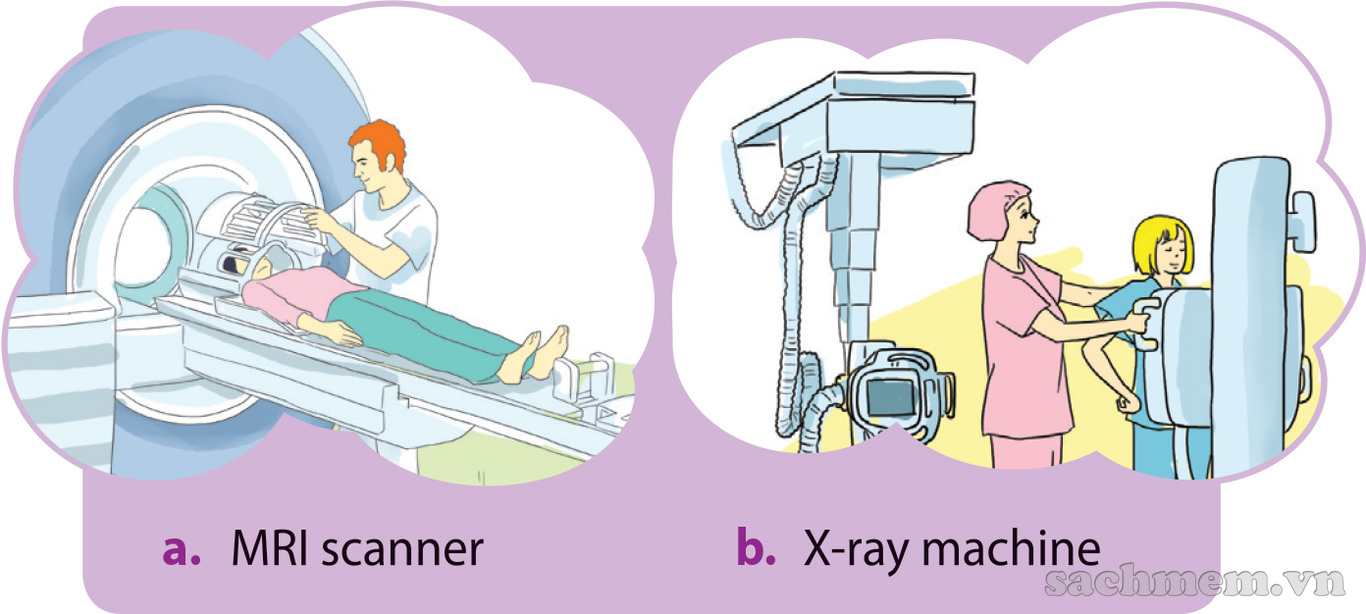
Reading - 2
2. Read an article about the main factors for the increased life expectancy. Four sentences have been removed from the article. Choose a sentence (a-d) to complete each gap (1-4).
(Đọc một bài báo về các yếu tố chính cho sự gia tăng tuổi thọ. Bốn câu đã được xoá khỏi bài báo. Chọn một câu (a-d) để hoàn thành mỗi khoảng cách (1-4).)
a. The last century's advances such as the discovery of antibiotics and vaccines, and the development of medical imaging have contributed to longer life.
b. Studies show that for each hour of regular exercise, people can gain two hours of additional life expectancy.
c. This increase can be attributed to three main factors: healthier lifestyles, better nutrition, and advances in medical science and technology
d. Eating more fruits and vegetables, but less fatty foods can reduce the risk of serious diseases.
Over the past hundred years, the average life expectancy has risen dramatically from 30 years in 1900 to 67.2 years in 2010, with Japan reaching the highest figure at 82.6 years. 1____________.
Mass media have helped to raise people's awareness of lifestyle choices. While smoking, alcohol intake and fast food consumption can increase the risk of obesity and heart disease, doing regular physical activity and spending more time outdoors can boost the body's strength and ability to function well. 2____________. Longevity is also linked with low levels of stress and anxiety. A popular way to relieve stress in today's busy lifestyles is practising meditation and yoga.
In addition to better living standards, people enjoy more nutritious diets and cleaner drinking water. Research shows that the food we eat can affect longevity, and even simple dietary changes can boost our immune system. 3____________.
The third factor responsible for the dramatic increase in life expectancy is the advanced technology and medical developments. 4____________. In the 21st century, scientists continue to look for new ways to treat serious diseases and slow down the ageing process. Many of these treatments and new developments have the potential to further prolong and improve the quality of life.
Reading - 3
3. Find the words or expressions in the text which have the following meanings.
(Tìm từ / cụm từ trong bài đọc có nghĩa như sau.)
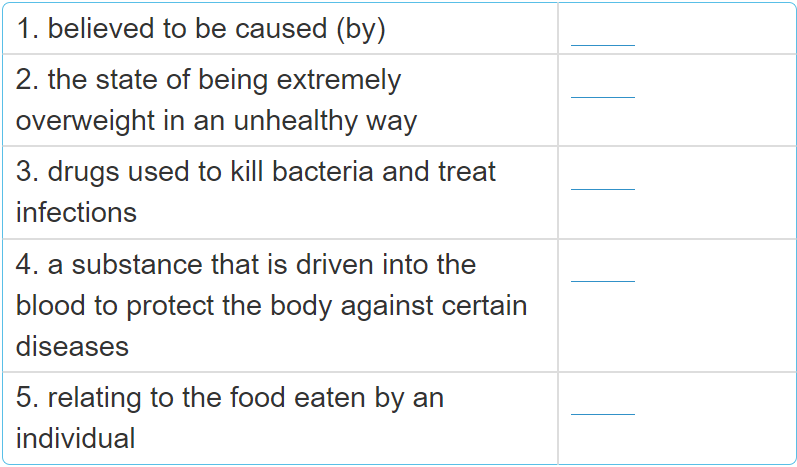
Reading - 4
4. Read the text again and answer the questions.
(Đọc lại bài đọc và trả lời câu hỏi.)
1. What are the factors responsible for the increase in life expectancy?
(Các nhân tố chịu giúp gia tăng tuổi thọ?)
2. What lifestyle choices can increase the risk of heart disease?
(Lựa chọn lối sống nào có thể làm tăng nguy cơ mắc bệnh tim?)
3. What can improve the ability of the human body to function well?
(Những gì có thể cải thiện khả năng của cơ thể con người giúp hoạt động tốt?)
4. Why do people practise yoga and meditation?
(Tại sao mọi người tập yoga và thiền định?)
5. Why is diet linked with longevity?
(Tại sao chế độ ăn uống liên quan đến tuổi thọ?)
6. What are the medical developments and advanced technology mentioned in the article?
(Những phát triển y tế và công nghệ tiên tiến được đề cập trong bài báo là gì?)
Reading - 5
5. Which of the factors mentioned in the article do you think is the most important? Discuss with a partner.
(Theo bạn yếu tố nào được đề cập trong bài báo là quan trọng nhất? Hãy thảo luận với bạn bên cạnh.)
Speaking - 1
Take care your body
(Chăm sóc cho cơ thể của bạn)
1. Below is a set of note cards for a talk about skincare. Use the words and phrases in the box to complete them.
(Dưới đây là những phiếu ghi chú cho một bài nói chuyện về cách bảo vệ da. Dùng từ và cụm từ cho trong khung để hoàn thành phần ghi chép đó.)
A. Introduction (1)
– Good morning.
– Today I'm going to talk about how to take care of your skin.
– Here are some tips for keeping your skin healthy and preventing common skin problems.
B. Skincare tips (2)
B1. Protecting your skin from the sun:
-
-
B2. Providing nutrients for healthy skin: (3)
-
-
B3. Preventing common skin problems: (4)
-
-
C. Conclusion (5)
– Healthy skin is essential to human survival. Therefore, you need to take good care of your skin by protecting it from the sun, eating well, and preventing common skin problems.
– Hope you find my tips useful. Thanks for listening.

Speaking - 2
2. Work in pairs. Use the note cards to talk about skincare, paving attention to the following:
(Làm việc theo cặp. Sử dụng các phiếu ghi chú về cách bảo vệ da, tập trung vào những điều sau đây.)
a. Glance at the notes; don't read from them.
(Nhìn lướt qua các ghi chú; không đọc chúng.)
b. Use linking words and expressions or hesitation devices to sound more natural and smooth.
(Sử dụng các từ liên kết và biểu thức hoặc thiết bị do dự để nghe tự nhiên hơn và trơn tru hơn.)
Examples: (Ví dụ)
I think / In my opinion / Firstly / Next / Moreover Well / Let me see / In fact / How can I put it?
(Tôi nghĩ / Theo ý kiến của tôi / Đầu tiên / Tiếp theo / Hơn nữa Vâng / Hãy để tôi nhìn thấy / Thực tế / Làm thế nào tôi có thể đặt nó?)
c. To make your tips sound more reliable, use reported speech to quote their sources.
(Để làm cho lời khuyên của bạn nghe đáng tin cậy hơn, hãy sử dụng lời nói được báo cáo để trích dẫn nguồn của họ.)
Examples: (Ví dụ)
Skin experts recommend wearing sunscreen with a sun protection factor of at least 15.
(Các chuyên gia da khuyên dùng kem chống nắng với yếu tố bảo vệ nắng ít nhất là 15.)
Studies show that eating a wide variety of fruit and vegetables can provide vitamins and nutrients for healthy skin.
(Các nghiên cứu cho thấy rằng ăn nhiều trái cây và rau cải có thể cung cấp vitamin và chất dinh dưỡng cho làn da khỏe mạnh.)
d. Maintain eye contact with your partner.
(Giữ liên lạc bằng mắt với bạn cộng tác của bạn.)
e. Use appropriate gestures and facial expressions to support your ideas.
(Sử dụng các cử chỉ thích hợp và các biểu hiện trên khuôn mặt để hỗ trợ những ý tưởng của bạn.)
Speaking - 3
3. Prepare another set of note cards for a talk about how to take care of your vision. Use the information below and your own ideas.
(Chuẩn bị một số ý chính viết trên các tờ ghi chép về cách chăm sóc thị lực. Dùng thông tin cho bên dưới và ý kiến cá nhân em để trình bày.)
Taking care of your vision (Chăm sóc thị lực)
– wear sunglasses to protect your eyes
(đeo kính mát đe báo vệ mắt)
– don’t stare at a computer screen for too long; look across the room every 30 minutes
(không dán mắt vào màn hình quá lâu: cứ 30 phút lại nhìn quanh căn phòng)
– read in well-lit rooms
(hãy đọc trong những phòng có ánh sáng tốt)
– keep a distance of at least 1.5 metres from the TV set
(giữ khoảng cách ít nhất cách ti vi 1,5m)
– follow doctor’s orders if you wear contact lenses
(tuân theo chỉ định của bác sĩ nếu bạn đeo kính áp tròng)
– see an eye specialist if you can’t see well or your eyes are injured
(gặp chuyên gia mat nếu bạn nhìn không rõ hoặc mắt bạn bị tổn thương)
Speaking - 4
4. Work in groups of four or five. Take turns to present your talk to your group members.
(Làm việc theo nhóm 4-5 người. Lần lượt trình bày ý kiến với các bạn trong nhóm.)
Listening - 1
Exercise precautions
(Thực hiện các biện pháp phòng ngừa)
1. Discuss with your partner.
(Thảo luận với bạn bên cạnh.)
a. Do you exercise everyday?
(Bạn có luyện tập hàng ngày không?)
b. If yes, what is your favourite activity? If not, why don't you exercise?
(Nếu có, hoạt động yêu thích của bạn là gì? Nếu không, tại sao bạn không tập thể dục?)
Listening - 2
2. Look at the pictures. Listen to John Keith, a fitness instructor, talking about four types of physical activity. Number the pictures as you listen.
(Nhìn tranh và lắng nghe John Keith, một huấn luyện viên sức khỏe đang nói về bốn loại hình thể dục. Đánh số các bức tranh khi em nghe.)
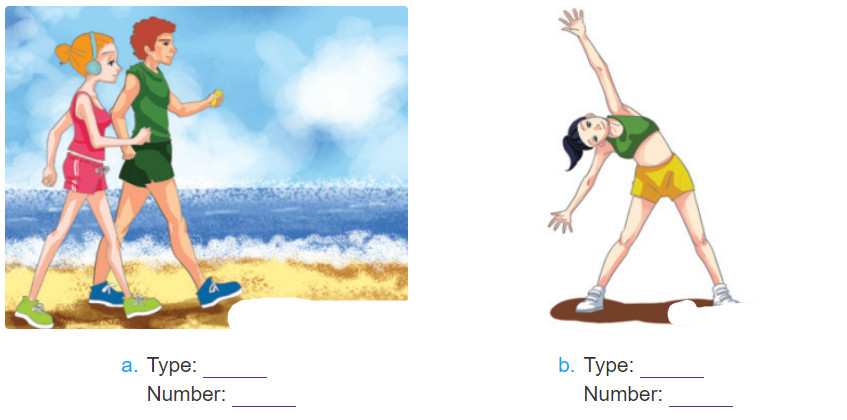

Listening - 3
3. Listen again. Which safety rules are mentioned to each type of physical activity? Tick the correct boxes.
(Nghe lại và nói xem nguyên tắc an toàn nào cho mỗi loại hình thể dục đang được đề cập đến.)
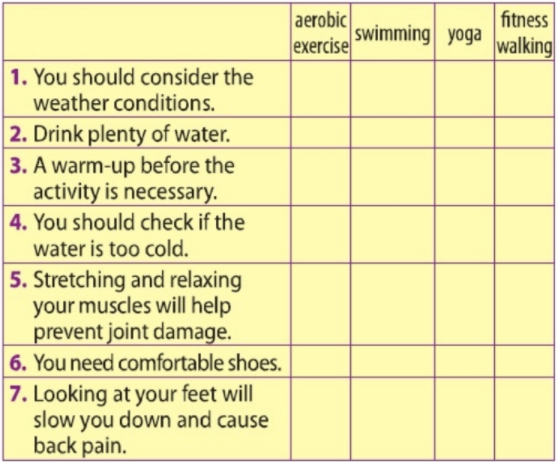
Listening - 4
4. Work in four groups. Each group chooses a different activity from 3. Discuss the following:
(Làm việc theo 4 nhóm. Mỗi nhóm chọn một hoạt động khác nhau từ bài tập 3 rồi thảo luận những vấn đề sau)
a. Health benefits (Lợi ích về sức khỏe)
b. Safety tips mentioned in the talk: Do you agree or disagree with them?
(Cách tập luyện an toàn được đề cập trong bài nói chuyện: Bạn đồng ý hay không đồng ý với họ?)
c. Add any additional precautions people may need to take.
(Bố sung thêm những cảnh báo an toàn mọi người có thể áp dụng.)
Example: (Ví dụ)
- Don’t do it after eating a full meal. (Đừng làm điều đó sau khi ăn no.)
- You need the instructions from a qualified coach. (Bạn cần hướng dẫn bởi một huấn luyện viên có trình độ.)
- Never do it alone. (Đừng bao giờ làm điều đó một mình.)
- Don’t do it if you are feeling unwell. (Đừng làm điều đó nếu bạn cảm thấy không khoẻ.)
Writing - 1
Lifestyle changes
(Thay đổi phong cách sống)
1. Read a story posted on Medicine, a website about fitness. Complete the story, using the correct form of the words in the box.
(Đọc một câu chuyện đăng trên trang Y Học, một trang web về sức khỏe. Hoàn thành câu chuyện, dùng dạng đúng của những từ cho trong khung.)
|
overweight support faint dieting appetite weight |
My fight against obesity
by Dan Smith
I am 24 years old. I used to have a huge (1) ________ as a child, ate a lot of fast food and became (2) ________. When I graduated from college, my weight had gone up to 100 kg. I started to apply for jobs and went to interviews, but I was never offered a single one. I could feel the interviewers' disappointment. Because of my size, they thought I was lazy and stupid. After hundreds of rejections, I decided that I need to do something about my weight.
I found a website advertising an effective way to lose (3) ________ in one month. I ate nothing and only drank water with a little salt and sugar. After ten days, I (4) ________ and was taken to hospital. The doctors told me that I would die if I did not stop (5) ________. They advised me to see Dr Liam, a dietician.
Dr Liam developed a healthy meal and exercise plan for me. For over a year, I had to follow a special diet and joined a fitness class for overweight people. It was difficult at first, but my family (6) ________ me during my fight against obesity. I have now reached my ideal weight and feel great. What is more, I have just received my first job offer.
Writing - 2
2. Read the story again and answer the questions.
(Đọc lại câu chuyện và trả lời câu hỏi.)
1. Why did Dan gain weight?
(Tại sao Dan lại tăng cân?)
2. When did he decide to lose weight?
(Khi nào anh ấy quyết định giảm cân?)
3. What kind of diet did he try at first? Was he successful?
(Chế độ ăn nào anh ấy thử lần đầu? Anh ấy có thành công không?)
4. How did he manage to reach a healthy weight?
(Làm thế nào anh ấy thành công trong việc đạt được cân nặng lý tưởng?)
5. Do you think overweight people are lazy and should not be employed until they lose weight?
(Bạn có nghĩ người thừa cân lười biếng và không nên được thuê cho đến khi họ giảm cân?)
Writing - 3
3. Use the information below to write a similar story.
(Dùng thông tin bên dưới để viết ra một câu chuyện tương tự.)
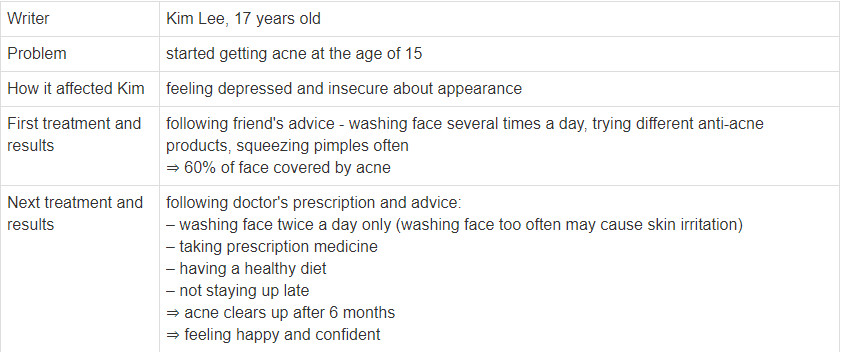
Mẹo tìm đáp án nhanh
Search Google: "từ khóa + baitap365" Ví dụ: "Bài 5 trang 13 SGK Vật lí 12 baitap365